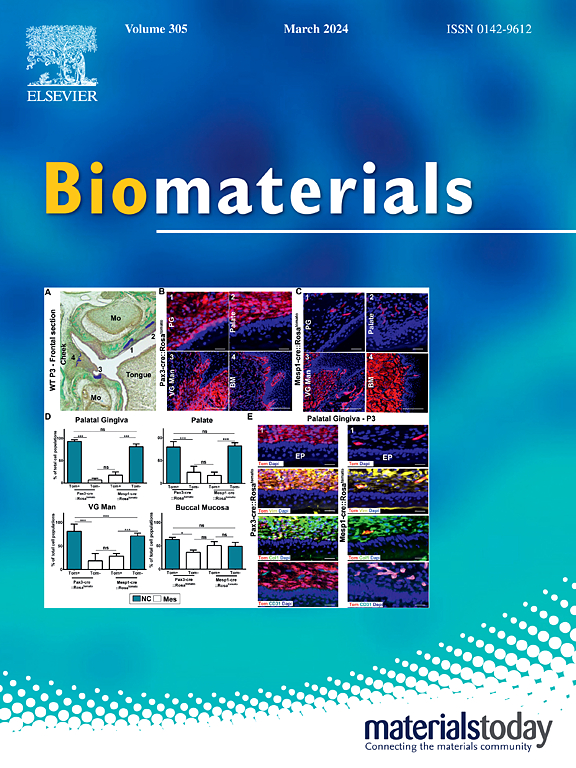间充质干细胞膜通过减轻氧化应激介导的神经炎症来伪装介孔多多巴胺治疗帕金森病
IF 12.9
1区 医学
Q1 ENGINEERING, BIOMEDICAL
引用次数: 0
摘要
帕金森氏病(PD)中活性氧(ROS)的过度积累导致氧化应激,从而诱导神经炎症并加速疾病进展。为了解决这个问题,我们开发了mPDA@MSC,这是一种纳米系统,由介孔聚多巴胺(mPDA)纳米颗粒组成,表面包裹有间充质干细胞膜(MSCm),具有清除ros的特性。mPDA结构显著增强了ros清除和抗炎活性,而表面包裹的MSCm能够有效地穿越血脑屏障,并靶向PD脑的病变部位。体外和体内研究均表明,mPDA@MSC通过多种机制发挥抗帕金森作用,包括清除ROS、调节线粒体功能障碍、促进促炎向抗炎小胶质细胞表型的转变。这导致多巴胺能神经元损伤逆转,α-突触核蛋白(α-syn)产生抑制,行为缺陷和其他表型改善。这些发现突出了mPDA@MSC作为PD治疗剂的潜力,并为抗PD治疗引入了一种新的方法。本文章由计算机程序翻译,如有差异,请以英文原文为准。
Mesenchymal stem cell membrane camouflaged mesoporous polydopamine for Parkinson's disease treatment via alleviating oxidative stress mediated neuroinflammation
Excessive accumulation of reactive oxygen species (ROS) in Parkinson's disease (PD) leads to oxidative stress, which induces neuroinflammation and accelerates disease progression. To address this, we developed mPDA@MSC, a nanosystem consisting of mesoporous polydopamine (mPDA) nanoparticles coated with a mesenchymal stem cell membrane (MSCm), which exhibits ROS-scavenging properties. The mPDA structure significantly enhanced ROS-scavenging and anti-inflammatory activities, while the surface-encapsulated MSCm enabled effective blood-brain barrier traversal and targeted the lesion site in the PD brain. Both in vitro and in vivo studies demonstrated that mPDA@MSC exerted anti-Parkinsonian effects through multiple mechanisms, including ROS scavenging, modulation of mitochondrial dysfunction, and promotion of the transition from pro-inflammatory to anti-inflammatory microglial phenotypes. This resulted in the reversal of dopaminergic neuron damage, inhibition of α-synuclein (α-syn) production, and improvement in behavioral deficits and other phenotypes. These findings highlight the potential of mPDA@MSC as a therapeutic agent for PD and introduce a novel approach to anti-PD therapy.
求助全文
通过发布文献求助,成功后即可免费获取论文全文。
去求助
来源期刊

Biomaterials
工程技术-材料科学:生物材料
CiteScore
26.00
自引率
2.90%
发文量
565
审稿时长
46 days
期刊介绍:
Biomaterials is an international journal covering the science and clinical application of biomaterials. A biomaterial is now defined as a substance that has been engineered to take a form which, alone or as part of a complex system, is used to direct, by control of interactions with components of living systems, the course of any therapeutic or diagnostic procedure. It is the aim of the journal to provide a peer-reviewed forum for the publication of original papers and authoritative review and opinion papers dealing with the most important issues facing the use of biomaterials in clinical practice. The scope of the journal covers the wide range of physical, biological and chemical sciences that underpin the design of biomaterials and the clinical disciplines in which they are used. These sciences include polymer synthesis and characterization, drug and gene vector design, the biology of the host response, immunology and toxicology and self assembly at the nanoscale. Clinical applications include the therapies of medical technology and regenerative medicine in all clinical disciplines, and diagnostic systems that reply on innovative contrast and sensing agents. The journal is relevant to areas such as cancer diagnosis and therapy, implantable devices, drug delivery systems, gene vectors, bionanotechnology and tissue engineering.
 求助内容:
求助内容: 应助结果提醒方式:
应助结果提醒方式:


